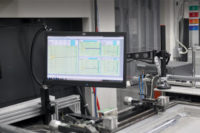Software
Trends In Total Quality Management
The field of TQM software has become crowded as more vendors attempt to enter the space, experts say.

Source: gorodenkoff/Creatas Video+ / Getty Images Plus via Getty Images
Total quality management is a way to describe a business environment where employees constantly improve their performance and are committed to maintaining high standards.
Before the 1950s, quality management was completely different – and not only because manufacturers didn’t have access to the technology we have today, says Otto de Graaf, CMO, AlisQI. Shop floor operators who had insights and first-hand experience with quality issues had no say in decision-making but relied on management for defining quality processes and controlling production lines. This all changed with Total Quality Management (TQM).
“Applying TQM principles, manufacturers could step away from the management-driven approach and transform their plant into a collaborative environment that finds value in every employee,” de Graaf says. “This shift in perspective recognizes the fact that quality is not only in the hands of a group of people but everyone in the organization contributes to it. Next to expanding the role of quality, TQM puts the customer first, focuses on integrated, process-centered quality management, continuous improvement, and fact-based decision making.”
For instance, a vendor in the food and agriculture sector can set up automated workflows and calendar notifications to keep track of its equipment’s condition and schedule calibrations, de Graaf explains. Or a shop floor operator in the chemicals industry can use the system to attach pictures and add relevant documents to his maintenance request. “A QMS can also be very handy to automate data exchange, or handovers between shifts or for assessing the standstill time of machines,” he says.
Total quality management can be broken down into two focus areas: quality assurance and quality control, says Tamela Serensits, founder/CEO, Argolytics.
Quality assurance, which deals primarily with documentation and reporting, is critical for achieving and maintaining certifications like ISO and AS standards, says Serensits. Quality control is geared toward measurement and data analysis to ensure quality.
“Given the left-brain/right-brain nature of these two topics, getting both right in a single TQM software package is a challenge,” Serensits says. “For example, a successful TQM software would include some way for operators on the shop floor to review standard operating procedures, enter inspection measurements, flag measurements that are out of tolerance, and submit a nonconformance report.”
The field of TQM software has become crowded as more vendors attempt to enter the space, says Ian R. Lazarus, president and CEO, Creato.
“Some of these startups have created little more than an Excel macro that sits on the existing Excel application,” Lazarus says. “Buyers would be advised to recognize the limits of these programs.”
Others go beyond compliance-oriented activities like audits and CAPA management and extend into the broad range of quality improvement methods, such as lean and Six Sigma. “Still others have consolidated all quality related software, [such as] project management, statistical tools, and visual mapping onto a single platform, enabling companies to reduce their overall spend on software,” he adds.
The field has changed very little in three decades, says Tony Burns, founder and CEO, Q-Skills3D.
“There are more e-learning development tools than ever but their capabilities have declined,” Burns says. “The reason is that they aim for the unskilled teacher to become a developer. Many even boast the ability to automatically turn boring Powerpoint into even more boring e-learning. This may be great for sales of the tools and the unskilled teacher, but it is terrible for the poor learner.”
So how should a manufacturer go about selecting the right TQM solution?
Look at published reviews on such sites as G2.com, Capterra, and others, says Lazarus. Assess vendors’ usability scores. Find the typical training requirement, course cost and ROI.
“The best products will have highest reviews, highest usability scores, lowest training requirement, and demonstrable ROI,” he says.
De Graaf suggests creating a cross-functional team to do the selection process. This team should carefully consider the manufacturer’s requirements, generate a long list to validate those requirements, then prune down both the list of vendors and requirements. He also suggests test-driving software before purchasing it.
“You should start adding value right from the start: automating even one process can be good enough to go live with a QMS”
“In addition to this, I’d urge buyers to think big and start small,” de Graaf says. “On the one hand, they need to look for an integrated solution: the QMS field is big, ranging from QC, SPC to EHS management, document management, [and] audit control. You want to make sure that you buy an integrated solution rather than multiple systems — a solution that can grow with you.”
On the other hand, de Graaf says, “we’ve learned enough from the many failed ERP implementations to know that you should start adding value right from the start: automating even one process can be good enough to go live with a QMS and then expanding your scope bit by bit.”
The industry has “come full circle” in how TQM systems are deployed, says Lazarus. Prior to SaaS and hosted programs, all software was sold as an on-premise solution, either by shipping CDs or allowing downloads over the web.
“You cannot buy many business-software programs this way anymore,” he says. “Everything is subscription based. However, with concerns over privacy and security, hosted solutions are being scrutinized more than ever. More and more companies, especially in government, defense, and biotech are demanding on-premise systems. The best companies will allow their customers to select from either a hosted or on-premise solution based on their specific requirements.”
There’s a lot of talk about AI in quality management that is confusing people, de Graaf says. “Quality management has been using statistics for around a century: statistical process control is a key element of good quality management,” he says. “In that sense, AI, which uses statistical algorithms at its core, is nothing new under the sun. It brings benefits to very specific areas, such as machine vision, but for many manufacturers it’s essential they cover the basics first before getting enchanted with AI.”
The biggest TQM trend may be a departure from stand-alone, desktop-installed software with an onsite database to a centrally-managed, third-party cloud application, Serensits says. “However, this is a challenge in some sensitive, government-regulated industries due to data security requirements,” she says.
Looking for a reprint of this article?
From high-res PDFs to custom plaques, order your copy today!







